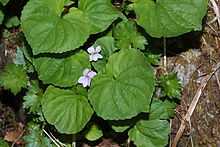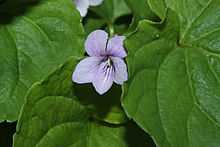Viola palustris
From Wikipedia, the free encyclopedia
| Viola palustris | |
|---|---|
 | |
| Scientific classification | |
| Kingdom: | Plantae |
| (unranked): | Angiosperms |
| (unranked): | Eudicots |
| (unranked): | Rosids |
| Order: | Malpighiales |
| Family: | Violaceae |
| Genus: | Viola |
| Species: | V. palustris |
| Binomial name | |
| Viola palustris L. | |
Viola palustris (marsh violet or alpine marsh violet) is a perennial forb of the genus Viola. It inhabits moist meadows, marshes, and streambanks in northern parts of North America and Eurasia.
Viola palustris is a 5 to 22 cm, glabrous herb with petioles and peduncles from slender rhizomes. The cordate to reniform leaves are 2.5 to 3.5 cm wide with coarse, shallow, blunt teeth. Petioles are 2 to 17 cm. The white to lilac flowers are 10 to 13 mm long. Peduncles are about the same length as petioles. The lower three petals have purple lines. The lateral pair are lightly bearded.
It is used as the foodplant for the Pearl-bordered Fritillary and the Small Pearl-bordered Fritillary
External links
![]() Media related to Viola palustris at Wikimedia Commons
Media related to Viola palustris at Wikimedia Commons
This article is issued from Wikipedia. The text is available under the Creative Commons Attribution/Share Alike; additional terms may apply for the media files.
